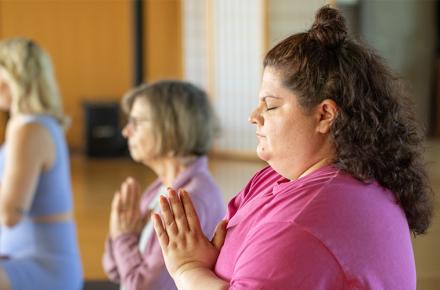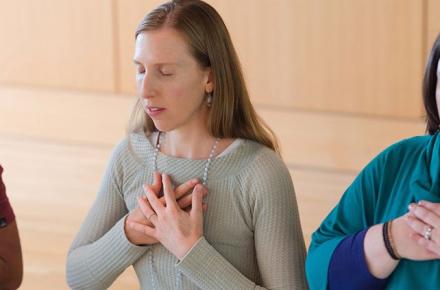Tending the Mind: Sattvic Practices for Addressing the Three Causes of Imbalance


Ayurveda teaches that imbalance causes disease, and that there are three main causes of imbalance. Two of these originate in the mind so, if you’re dealing with an imbalance, there’s a 66 percent chance that it started in your noodle.
As an Ayurvedic consultant, I find that psychology is one of the most fascinating—and often most challenging—aspects of working with clients. The mind can create imbalance, and it can also help correct it.
Sattva is the natural state of the mind when imbalance is not present. We know we are in a sattvic state when our minds are settled, our bodies are free of anxiety and agitation, and we feel a sense of calm and harmony.
Let’s look at the three causes of imbalance, and the practices that can help us find our way back to sattva.
Parinama: Time
The first cause of disease is said to be parinama, or causes and conditions related to time. These are imbalances that relate to the seasons and time of year, time of day, or time of life. We can’t control these changes. We are going to age, and with aging come conditions due to age. Our skin will change, our bones will change, our hair changes.
But aging doesn’t have to equal disease. If we live with the reality of each new season of our life, we can make diet and lifestyle adjustments along the way in order to maintain harmony. Just as, in New England, we have large closets to accommodate all the various jackets we need all year, we need the right food, clothing, and lifestyle to balance the natural elements of the season. In summer, we eat lots of fresh fruits and vegetables; in winter, we favor soups and roasted vegetables. We can learn to tune in to our natural intuition to let us know what we need to stay balanced in different times of year, as well as different times of our lives. Each phase of our life requires a specific kind of care.
Prajnaparadha: Mistakes of the Intellect
Pronounced pragy-a-parad-ha, this is one of my favorite theories in Ayurveda. It means, essentially, an offense against wisdom, a mistake of the intellect, or intellectual blasphemy. One of my first Ayurveda teachers, Partap Chauhan referred to this as “mafia mind”—when we know that we shouldn’t do something but we do it anyway. We go against our higher wisdom and disregard what Swami Kripalu referred to as witness consciousness.
The reality is that everyone does this. We all override our highest self for a host of reasons. When we are tired, we drink caffeine instead of taking a nap. When we know we should go to bed, we devour one more episode of The Crown. We push through injuries to “perfect” a yoga pose. We work too many hours when what we really need is a vacation. The list is exhaustive.
If we do this sometimes, it’s not a big deal. It’s the cumulative effect that we want to pay attention to. Our body and mind send us gentle (and sometimes not-so-gentle) signals about what we need. Ignoring these signals can lead to imbalances that result in chronic or severe disease.
Asatmendriyartha Samyoga: Misuse of the Senses
This is a long Sanskrit word. Here it goes: ah-sat-myen-driya-arta-sam-yoga. This third cause of disease has to do with how we use our sense organs—or, more accurately, how we misuse them. I always find it hard to imagine how people misused their senses back when the ancient Ayurvedic sages were constructing these theories. What was the most stimulating activity available? Too much time by the fire? Too much star gazing? Eating too many berries? Could they have imagined the world we live in today?
Ayurveda teaches us that we are made up of the body, mind, senses, and soul. It is one of the first concepts described in the first chapters of the ancient text Charaka Samhita. There is an enormous amount of time in Ayurveda dedicated to nourishing and cleansing our senses. But, what is even more important is how we protect our senses from the everyday battering we get just from existing in this modern world. The average time spent on a screen is 11 hours per day. For millions of years, we used our bodies for work, and now we use our minds and exhaust our eyes and ears. There is actually a term called “computer vision syndrome” which is a catch all term for any eye discomfort from screen abuse—headaches, sore eyes, blurred eyes, dry, tearing and burning eyes. Joan Portello, an optometry professor and researcher, recommends the 20-20-20 rule: Every 20 minutes, look away from your screen at something 20 feet away for 20 seconds.
Screen overuse leads to disturbances not only of the eyes, but also of the mind. I can’t find in the classics any information about iPhones, but current research shows us that “internet addiction is associated with structural and functional changes in brain regions involving emotional processing, executive attention, decision making, and cognitive control.” Even if you’re not addicted to your screen, high levels of use can cause symptoms such as insomnia, lack of deep restorative sleep, and a hyper-sensitized nervous system.
Sattva Boosting for the Mind
So how do we counteract these three causes of imbalance? Spending time in nature is one of the best ways to combat misuse of the intellect and misuse of the senses. Being in nature allows our eyes to relax, moving from fixed focus to soft focus as we take in the landscape, trees, clouds, moon, and stars. Take your earbuds out and allow your attention to float to the sounds of the birds and the gentle whisper of the wind, or sit by a creek and listen to the water flowing. Lie on the grass. Walk in the woods. Swim in a lake, ocean, or pond. Recognize the magnificence of the natural world.
Eat foods that are local and seasonal; savor the ripe peach, cooling watermelon, crisp apple, and sweet carrot. Favor foods that are easy to digest, such as basmati rice, cooked vegetables, and small legumes—like mung beans doused with a dollop of organic ghee. Eat mindfully, with good company, in a clean, peaceful atmosphere.
More than anything, Ayurveda invites us to get closer to the truth of who we are when we take down our Facebook page and Instagram account. The heart is longing for us to wake up to the still voice of harmony that resides in our deepest wisdom.
Find out about upcoming trainings in the Kripalu School of Ayurveda.
© Kripalu Center for Yoga & Health. All rights reserved. To request permission to reprint, please email editor@kripalu.org.
















































